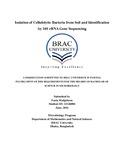| dc.contributor.advisor | Hossain, Dr. Mahboob | |
| dc.contributor.advisor | Khan, Trosporsha Tasnim | |
| dc.contributor.author | Mahjabeen, Faria | |
| dc.date.accessioned | 2017-05-07T08:49:00Z | |
| dc.date.available | 2017-05-07T08:49:00Z | |
| dc.date.copyright | 2016 | |
| dc.date.issued | 2016-06 | |
| dc.identifier.other | ID 12126004 | |
| dc.identifier.uri | http://hdl.handle.net/10361/8098 | |
| dc.description | This thesis report is submitted in partial fulfillment of the requirement for the degree of B.Sc in Microbiology, 2016. | en_US |
| dc.description | Cataloged from PDF version of thesis report. | |
| dc.description | Includes bibliographical references (page 61-68). | |
| dc.description.abstract | Cellulases have an escalating demand in many industries as they hold extreme potency for converting the most abundant lignocellulosic material into renewable and sustainable energy, chemicals, fuels and materials. Hence, studies pursue to unfold a novel cellulase that can overcome existing challenges in biorefinery, reduce biofuel production cost, as well as have tremendous applications in industrial processes. Therefore, soil from a dairy farm was screened for potent cellulase producers on CMC agar and the best isolate so far had an extracellular crude enzyme activity of 0.167U/ml and specific activity of 0.333U/mg. The cell morphology, cultural characteristics and biochemical tests revealed the isolate to be facultative anaerobe, gram positive, non motile spore forming rods and presumptively identified it to belong to the genus
Bacillus. Later on, molecular analysis was carried out by initially amplifying the 16S rRNA gene of the isolate using universal primers 27F and 1492R vie polymerase chain reaction method. The 16S rRNA gene was further sequenced using Sanger sequencing method which revealed the length of the nucleotide sequence to be 1381bp. The sequence was compared to the NCBI nucleotide database. Afterwards a phylogenetic tree was constructed by maximum likelihood method. The organism was found to be Bacillus subtilis as indicated by its presence in the same node with Bacillus subtilis subsp. spizizenii. The isolate obtained shows good cellulase activity but requires further characterization to determine its potentiality as an industrial producer of cellulase. | en_US |
| dc.description.statementofresponsibility | Faria Mahjabeen | |
| dc.format.extent | 79 pages | |
| dc.language.iso | en | en_US |
| dc.publisher | BRAC University | en_US |
| dc.rights | BRAC University thesis are protected by copyright. They may be viewed from this source for any purpose, but reproduction or distribution in any format is prohibited without written permission. | |
| dc.subject | Cellulolytic bacteria | en_US |
| dc.subject | | en_US |
| dc.subject | Gene sequencing | en_US |
| dc.title | Isolation of cellulolytic bacteria from soil and identification by 16S rRNA gene sequencing | en_US |
| dc.type | Thesis | en_US |
| dc.contributor.department | Department of Mathematics and Natural Sciences, BRAC University | |
| dc.description.degree | B. Microbiology | |

